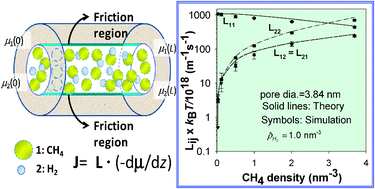Molecular transport in nanopores plays a central role in many emerging nanotechnologies for gas separation and storage, as well as in nanofluidics. Theories of the transport provide an understanding of the mechanisms that influence the transport and their interplay, and can lead to tractable models that can be used to advance these nanotechnologies through process analysis and optimisation. We review some of the most influential theories of fluid transport in small pores and confined spaces. Starting from the century old Knudsen formulation, the dusty gas model and several other related approaches that share a common point of departure in the Maxwell–Stefan diffusion equations are discussed. In particular, the conceptual basis of the models and the validity of the assumptions and simplifications necessary to obtain their final results are analysed. It is shown that the effect of adsorption is frequently either neglected, or treated on an ad hoc basis, such as through the division of the pore flux into gas-phase and surface diffusion contributions. Furthermore, while it is commonplace to assume that cross-sectional pressure is uniform, it is demonstrated that this violates the Gibbs–Duhem relation and that it is the chemical potential that essentially remains constant in the cross-section, as near-equilibrium density profiles are preserved even during transport. The Dusty Gas model and Maxwell–Stefan model for surface diffusion are analysed, and their strengths and weaknesses discussed, illustrating the use of conflicting choices of frames of reference in the former case, and the importance of assigning appropriate values for the binary diffusivity in the latter case. The oscillator model, developed in this laboratory, which is exact in the low density limit under diffuse reflection conditions, is shown to represent an advance on the classical Knudsen formula, although the latter frequently appears as a fundamental part of many transport models. The distributed friction model, also developed in this laboratory for the study of multi-component transport at any Knudsen number is discussed and compared with previous approaches. Finally, the outlook for theory and future research needs are discussed.


 Please wait while we load your content...
Please wait while we load your content...